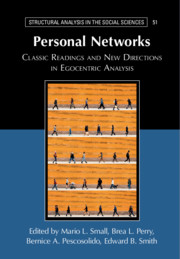Book contents
- Personal Networks
- Structural Analysis in the Social Sciences
- Personal Networks
- Copyright page
- Contents
- Figures
- Tables
- Contributors
- I Background
- II Early Foundations
- III Later Foundations
- IV New Perspectives
- 20 On Cognition
- 21 On Mobilization
- 22 On Trust
- 23 On Dynamics
- 24 On Inequality
- 25 On Culture
- 26 On Migration
- 27 On Movements
- 28 On Social Media
- Index
- Recent Books in the Series
- References
22 - On Trust
Self-Verification, Trust, and Social Capital Mobilization
from IV - New Perspectives
Published online by Cambridge University Press: 01 October 2021
- Personal Networks
- Structural Analysis in the Social Sciences
- Personal Networks
- Copyright page
- Contents
- Figures
- Tables
- Contributors
- I Background
- II Early Foundations
- III Later Foundations
- IV New Perspectives
- 20 On Cognition
- 21 On Mobilization
- 22 On Trust
- 23 On Dynamics
- 24 On Inequality
- 25 On Culture
- 26 On Migration
- 27 On Movements
- 28 On Social Media
- Index
- Recent Books in the Series
- References
Summary
A growing body of research has examined the role that trust plays in the mobilization of social capital for instrumental and emotional aid. Few have theorized, however, how individuals’ own notions of self, and their need for self-confirmation, shape the process by which they de-cide who to help, when, under what circumstances, and why. In this paper, we consider the role that self-verification plays in the development of trust that facilitates social capital mobiliza-tion for emotional and instrumental aid, with specific attention to job-matching assistance. We draw from the work of social psychologists to suggest that we might better understand the cir-cumstances under which people provide instrumental and emotional aid by considering the extent to which their self-views, positive or negative, are confirmed by others around them. Self-verification should feed trust that produces a greater willingness to offer both emotional and instrumental aid. We illustrate this point with a discussion of one empirical case.
Keywords
- Type
- Chapter
- Information
- Personal NetworksClassic Readings and New Directions in Egocentric Analysis, pp. 596 - 611Publisher: Cambridge University PressPrint publication year: 2021



